Data Source Manual
Introduce how to use the new feature function data source of version 1.1.0
1. Data source function introduction
1.1 Concept
- Data source: We call database services that can provide data storage as databases, such as mysql/hive/kafka. The data source defines the configuration information for connecting to the actual database. The configuration information is mainly the address required for connection and user authentication information , connection parameters, etc. Stored in the linkisps_dm_datasource* table related to the linkis database
- Metadata: simply refers to the metadata of the database, which refers to the data that defines the data structure and the data of various object structures of the database. For example, the database name, table name, column name, field length, type and other information data in the database.
1.2 Three main modules
linkis-datasource-client Client module, DataSourceRemoteClient for basic management of user data sources, and MetaDataRemoteClient for metadata query operations.
linkis-datasource-manager-server Data source management module, service name ps-data-source-manager. Perform basic management of data sources, and provide http interfaces such as adding, querying, modifying, and connection testing of external data sources. The rpc service is provided internally, which is convenient for the data element management module to call through rpc to query the necessary information needed to establish a connection to the database.
- http interface documentation
- http interface class org.apache.linkis.metadatamanager.server.restful
- rpc interface class org.apache.linkis.metadatamanager.server.receiver
linkis-metedata-manager-server Data element management module, service name ps-metadatamanager. It provides the basic query function of the data metadata of the database, provides the http interface externally, and provides the rpc service internally, which is convenient for the data source management module to perform the connection test of the data source through the rpc call.
- http interface documentation
- http interface class org.apache.linkis.datasourcemanager.core.restful
- rpc interface class org.apache.linkis.datasourcemanager.core.receivers
1.3 Processing logic
1.3.1 LinkisDataSourceRemoteClient
The functional structure diagram is as follows:
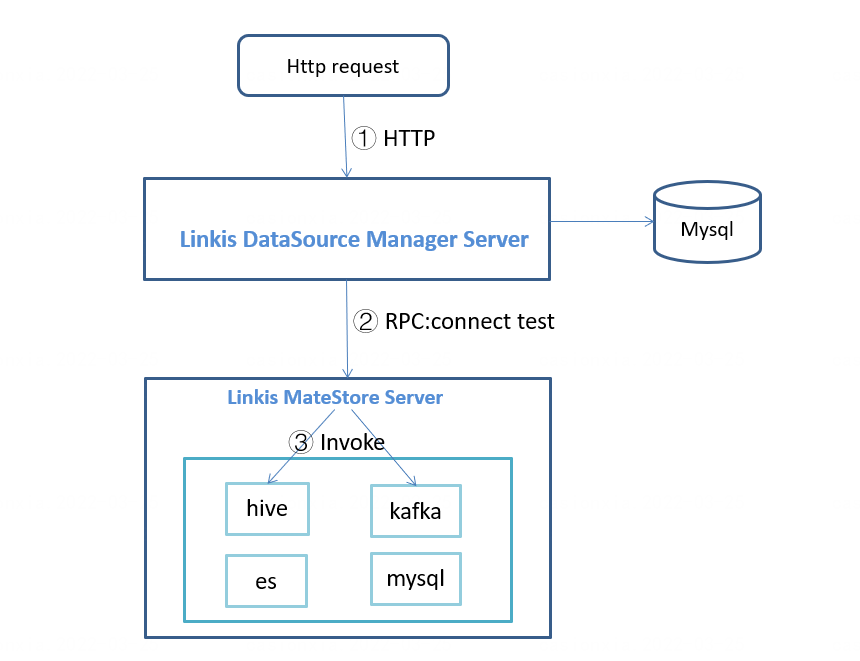
- The LinkisDataSourceRemoteClient client assembles the http request according to the request parameters,
- HTTP request sent to linkis-ps-data-source-manager
- linkis-ps-data-source-manager will perform basic parameter verification, some interfaces can only be operated by the administrator role
- linkis-ps-data-source-manager performs basic data operations with the database
- The data source test connection interface provided by linkis-ps-data-source-manager internally uses rpc to call the ps-metadatamanager method for connection test
- The data result after the http request is processed will be mapped and converted from the result set to the entity class by annotating the DWSHttpMessageResult function
LinkisDataSourceRemoteClient interface
- GetAllDataSourceTypesResult getAllDataSourceTypes(GetAllDataSourceTypesAction) Query all data source types
- QueryDataSourceEnvResult queryDataSourceEnv(QueryDataSourceEnvAction) Query the cluster configuration information that can be used by the data source
- GetInfoByDataSourceIdResult getInfoByDataSourceId(GetInfoByDataSourceIdAction): query data source information by data source id
- QueryDataSourceResult queryDataSource(QueryDataSourceAction) query data source information
- GetConnectParamsByDataSourceIdResult getConnectParams(GetConnectParamsByDataSourceIdAction) Get connection configuration parameters
- CreateDataSourceResult createDataSource(CreateDataSourceAction) to create a data source
- DataSourceTestConnectResult getDataSourceTestConnect(DataSourceTestConnectAction) to test whether the data source can be connected normally
- DeleteDataSourceResult deleteDataSource(DeleteDataSourceAction) deletes the data source
- ExpireDataSourceResult expireDataSource(ExpireDataSourceAction) sets the data source to expired state
- GetDataSourceVersionsResult getDataSourceVersions(GetDataSourceVersionsAction) Query the version list of the data source configuration
- PublishDataSourceVersionResult publishDataSourceVersion(PublishDataSourceVersionAction) publishes the data source configuration version
- UpdateDataSourceResult updateDataSource(UpdateDataSourceAction) to update the data source
- UpdateDataSourceParameterResult updateDataSourceParameter(UpdateDataSourceParameterAction) Update data source configuration parameters
- GetKeyTypeDatasourceResult getKeyDefinitionsByType(GetKeyTypeDatasourceAction) Query the configuration properties required by a data source type
1.3.2 LinkisMetaDataRemoteClient
The functional structure diagram is as follows:
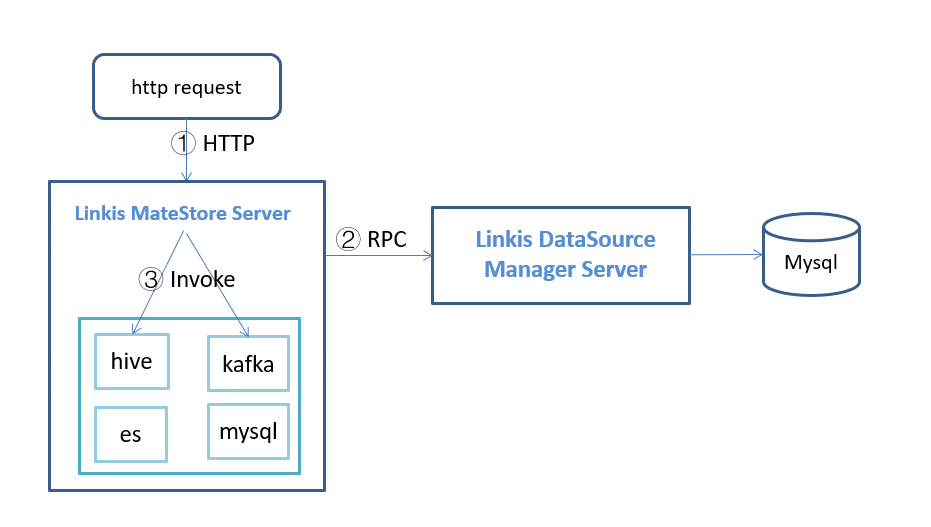
- LinkisMetaDataRemoteClient client, according to the request parameters, assemble the http request,
- HTTP request sent to ps-metadatamanager
- ps-metadatamanager will perform basic parameter verification,
- The request will send an RPC request to linkis-ps-data-source-manager based on the parameter datasourceId to obtain the type of the data source, connection parameters such as username and password, etc.
- After getting the information required for the connection, load the lib package in the corresponding directory according to the data source type, and call the corresponding function method through the reflection mechanism to query the metadata information
- The data result after the http request is processed will be mapped and converted from the result set to the entity class by annotating the DWSHttpMessageResult function
LinkisMetaDataRemoteClient interface
- MetadataGetDatabasesResult getDatabases(MetadataGetDatabasesAction) query database list
- MetadataGetTablesResult getTables(MetadataGetTablesAction) query table data
- MetadataGetTablePropsResult getTableProps(MetadataGetTablePropsAction)
- MetadataGetPartitionsResult getPartitions(MetadataGetPartitionsAction) query partition table
- MetadataGetColumnsResult getColumns(MetadataGetColumnsAction) query data table fields
1.3 Source module directory structure
linkis-public-enhancements/linkis-datasource
├── linkis-datasource-client //client code
├── linkis-datasource-manager //Datasource management module
│ ├── common //Data source management common module
│ └── server //Data source management service module
├── linkis-metadata //Module existing in the old version, reserved
├── linkis-metadata-manager //Data Metadata Management Module
│ ├── common //Data element management common module
│ ├── server //Data element management service module
│ └── service //Supported data sources
│ ├── elasticsearch
│ ├── hive
│ ├── kafka
│ └── mysql
1.4 Installation package directory structure
/lib/linkis-public-enhancements/
├── linkis-ps-data-source-manager
├── linkis-ps-metadatamanager
│ └── service
│ ├── elasticsearch
│ ├── hive
│ ├── kafka
│ └── mysql
wds.linkis.server.mdm.service.lib.dir controls the classpath loaded during reflection calls. The default value of the parameter is /lib/linkis-public-enhancements/linkis-ps-metadatamanager/service
1.5 Configuration Parameters
See Tuning and Troubleshooting>Parameter List#datasourceConfiguration Parameters
1.6 Installation extra data drivers
1.Some data drivers require to be installed by user's self, because they are possibly not compatible with the Apache license
2.Extra data driver directory: ./lib/linkis-public-enhancements/linkis-ps-publicservice
3.Data drivers list
| Driver Name | Driver Version | Download Link |
|---|---|---|
| db2 | db2jcc4 | https://www.ibm.com/support/pages/db2-jdbc-driver-versions-and-downloads |
| dameng | DmJdbcDriver18 | https://download.dameng.com/eco/docs/JAVA_Mybatis_lib.zip |
| mysql | 5.1.34 | https://repo1.maven.org/maven2/mysql/mysql-connector-java/5.1.34/mysql-connector-java-5.1.34.jar |
| kingbase | kingbase8 | http://maven.jeecg.org/nexus/content/repositories/jeecg/kingbase/kingbase8/8/kingbase8-8.jar |
| greenplum | 5.1.4 | https://network.pivotal.io/products/vmware-tanzu-greenplum#/releases/985537/file_groups/5749 |
| postgresql | 42.3.1 | https://repo1.maven.org/maven2/org/postgresql/postgresql/42.3.1/postgresql-42.3.1.jar |
| sqlserver | sqlserver2000 | https://www.microsoft.com/en-us/download/details.aspx?id=11774 |
| oracle | 11.2.0.3 | http://www.datanucleus.org/downloads/maven2/oracle/ojdbc6/11.2.0.3/ojdbc6-11.2.0.3.jar |
2. Enable data source function
In the startup script of linkis, the two services related to the data source (ps-data-source-manager, ps-metadatamanager) will not be started by default.
If you want to use the data source service, you can enable it in the following ways:
Modify export ENABLE_METADATA_MANAGER=true in $LINKIS_CONF_DIR/linkis-env.sh to true.
When the service is started and stopped through linkis-start-all.sh/linkis-stop-all.sh, the data source service will be started and stopped.
Check whether the service starts normally through the eureka page

- Management of linkis The web version needs to be upgraded to version 1.1.0 to use the data source management page function on the linkis console.
- At present, there are jar packages of mysql/hive/kafak/elasticsearch in the data source, but the kafak/elasticsearch data source has not been strictly tested, and the complete availability of functions is not guaranteed.
3. Use of data sources
The use of data sources is divided into three steps:
- step 1. Create data source/configure connection parameters
- step 2. Publish the data source and select the connection configuration version to use
- step 3. Data source usage, query metadata information , hive/kafka/elasticsearch configuration is associated with the corresponding cluster environment configuration.
3.1 Mysql data source
3.1.1 Created through the management console
You can only create configuration data sources, and test whether the data sources can be connected normally, and cannot directly query metadata
Implement a JDBC generic module, and then choose any item mentioned below on the web UI.
| Data Source | Link |
|---|---|
| mysql | https://www.mysql.com |
| oracle | https://www.oracle.com/database/technologies |
| kingbase | https://www.kingbase.com.cn |
| postgresql | https://www.postgresql.org |
| sqlserver | https://www.microsoft.com/en-us/sql-server |
| db2 | https://www.ibm.com/products/db2/database |
| greenplum | https://greenplum.org |
| dm | https://dmdatabases.com |
| doris | https://doris.apache.org |
| clickhouse | https://clickhouse.com |
Take MySQL as an example:
Data Source Management > New Data Source > Select MySQL Type
Enter relevant configuration information
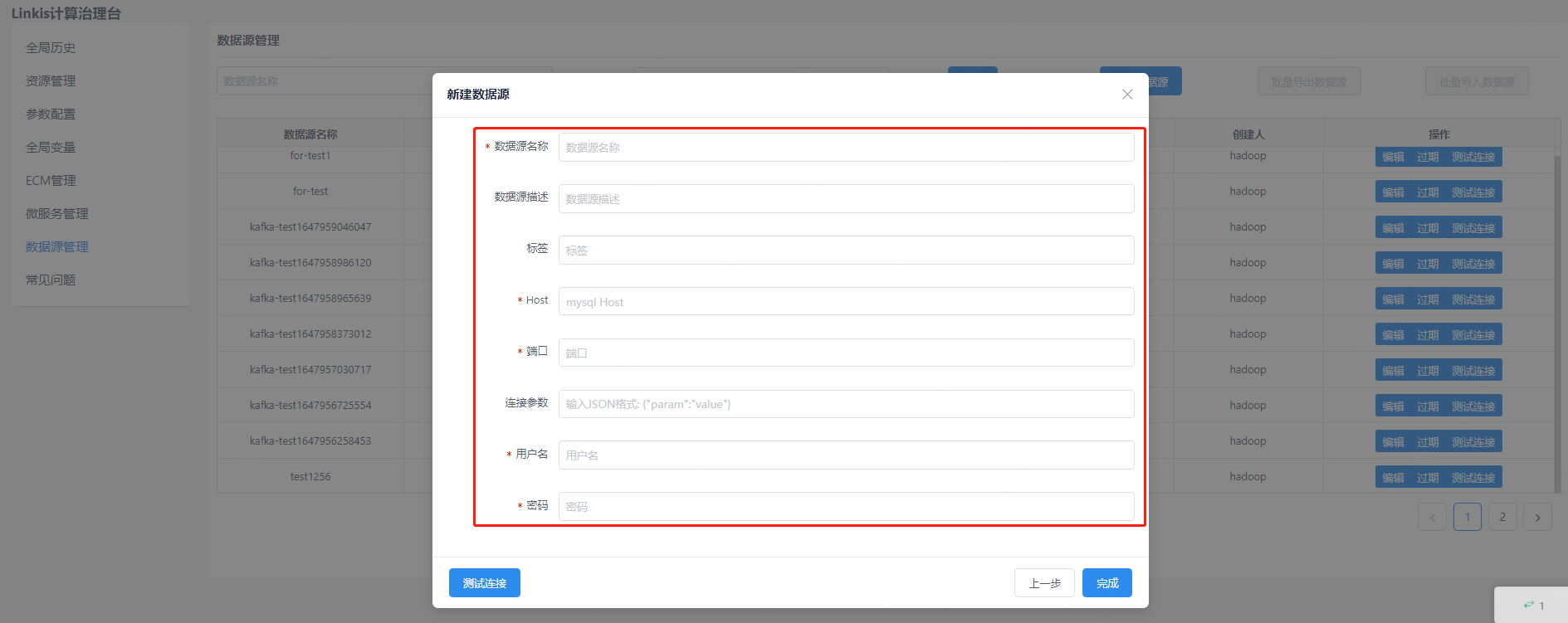
After the entry is successful, you can pass the connection test to verify whether the connection can be made normally
- The system to which the data source created through the management console belongs is Linkis
- After the creation is successful, it needs to be published (switching and selecting the configuration parameter version when publishing) before it can be used normally
Publishing of the configuration (using that configuration for the connection to the data source):
Click on the version and then pop up the page to select the appropriate configuration to publish
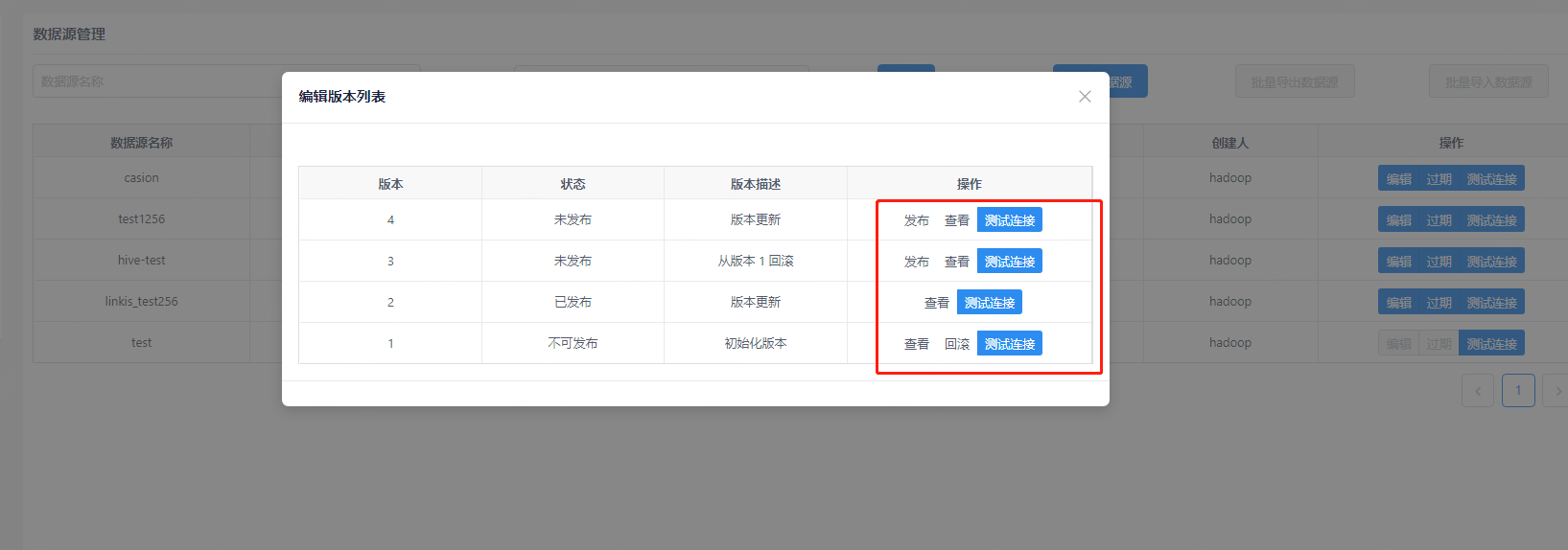
3.1.2 Using the client
scala code example:
package org.apache.linkis.datasource.client
import java.util
import java.util.concurrent.TimeUnit
import org.apache.linkis.common.utils.JsonUtils
import org.apache.linkis.datasource.client.impl.{LinkisDataSourceRemoteClient, LinkisMetaDataRemoteClient}
import org.apache.linkis.datasource.client.request._
import org.apache.linkis.datasource.client.response._
import org.apache.linkis.datasourcemanager.common.domain.DataSource
import org.apache.linkis.httpclient.dws.authentication.StaticAuthenticationStrategy
import org.apache.linkis.httpclient.dws.config.DWSClientConfigBuilder
import org.junit.jupiter.api.{Disabled, Test}
object TestMysqlClient {
val gatewayUrl = "http://127.0.0.1:9001"
val clientConfig = DWSClientConfigBuilder.newBuilder
.addServerUrl(gatewayUrl)
.connectionTimeout(30000)
.discoveryEnabled(false)
.discoveryFrequency(1, TimeUnit.MINUTES)
.loadbalancerEnabled(true)
.maxConnectionSize(1)
.retryEnabled(false)
.readTimeout(30000)
.setAuthenticationStrategy(new StaticAuthenticationStrategy)
.setAuthTokenKey("hadoop")
.setAuthTokenValue("xxxxx")
.setDWSVersion("v1")
val dataSourceclient = new LinkisDataSourceRemoteClient(clientConfig.build())
val clientConfig2 = DWSClientConfigBuilder.newBuilder
.addServerUrl(gatewayUrl)
.connectionTimeout(30000)
.discoveryEnabled(false)
.discoveryFrequency(1, TimeUnit.MINUTES)
.loadbalancerEnabled(true)
.maxConnectionSize(1)
.retryEnabled(false)
.readTimeout(30000)
.setAuthenticationStrategy(new StaticAuthenticationStrategy)
.setAuthTokenKey("hadoop")
.setAuthTokenValue("xxxxx")
.setDWSVersion("v1")
val metaDataClient = new LinkisMetaDataRemoteClient(clientConfig2.build())
@Test
@Disabled
def testCreateDataSourceMysql: Unit = {
val user = "hadoop"
val system = "Linkis"
//create data source
val dataSource = new DataSource();
val dataSourceName = "for-mysql-test"
dataSource.setDataSourceName(dataSourceName)
dataSource.setDataSourceDesc("this is for mysql test")
dataSource.setCreateSystem(system)
dataSource.setDataSourceTypeId(1L)
val map = JsonUtils.jackson.readValue(JsonUtils.jackson.writeValueAsString(dataSource), new util.HashMap[String, Any]().getClass)
val createDataSourceAction: CreateDataSourceAction = CreateDataSourceAction.builder()
.setUser(user)
.addRequestPayloads(map)
.build()
val createDataSourceResult: CreateDataSourceResult = dataSourceclient.createDataSource(createDataSourceAction)
val dataSourceId = createDataSourceResult.getInsertId
// set connection parameters
val params = new util.HashMap[String, Any]
val connectParams = new util.HashMap[String, Any]
connectParams.put("host", "127.0.0.1")
connectParams.put("port", "36000")
connectParams.put("username", "db username")
connectParams.put("password", "db password")
params.put("connectParams", connectParams)
params.put("comment", "init")
val updateParameterAction: UpdateDataSourceParameterAction = UpdateDataSourceParameterAction.builder()
.setUser(user)
.setDataSourceId(dataSourceId)
.addRequestPayloads(params)
.build()
val updateParameterResult: UpdateDataSourceParameterResult = dataSourceclient.updateDataSourceParameter(updateParameterAction)
val version: Long = updateParameterResult.getVersion
//publish configuration version
dataSourceclient.publishDataSourceVersion(
PublishDataSourceVersionAction.builder()
.setDataSourceId(dataSourceId)
.setUser(user)
.setVersion(version)
.build())
// use example
val metadataGetDatabasesAction: MetadataGetDatabasesAction = MetadataGetDatabasesAction.builder()
.setUser(user)
.setDataSourceName(dataSourceName)
.setSystem(system)
.build()
val metadataGetDatabasesResult: MetadataGetDatabasesResult = metaDataClient.getDatabases(metadataGetDatabasesAction)
val metadataGetTablesAction: MetadataGetTablesAction = MetadataGetTablesAction.builder()
.setUser(user)
.setDataSourceName(dataSourceName)
.setDatabase("linkis")
.setSystem(system)
.build()
val metadataGetTablesResult: MetadataGetTablesResult = metaDataClient.getTables(metadataGetTablesAction)
val metadataGetColumnsAction = MetadataGetColumnsAction.builder()
.setUser(user)
.setDataSourceName(dataSourceName)
.setDatabase("linkis")
.setSystem(system)
.setTable("linkis_datasource")
.build()
val metadataGetColumnsResult: MetadataGetColumnsResult = metaDataClient.getColumns(metadataGetColumnsAction)
}
}
3.1.3 JDBC EngineConn supported by Linkis
- MySQL
- Oracle
- KingBase
- PostgreSQL
- SQLServer
- DB2
- Greenplum
- DM
- Doris
- ClickHouse
- TiDB
- Starrocks
- Gaussdb
- OceanBase
3.2 Hive data source
3.2.1 Created through the management console
You can only create configuration data sources, and test whether the data sources can be connected normally, and cannot directly query metadata
First need to configure the cluster environment information
Table linkis_ps_dm_datasource_env
INSERT INTO `linkis_ps_dm_datasource_env`
(`env_name`, `env_desc`, `datasource_type_id`, `parameter`, `create_user`, `modify_user`)
VALUES
('testEnv', 'Test Environment', 4,
'{\r\n "uris": "thrift://clustername:9083",\r\n "keytab": "4dd408ad-a2f9-4501-83b3-139290977ca2",\r\n "principle": "hadoop @WEBANK.COM",\r\n "hadoopConf":{"hive.metastore.execute.setugi":"true"}\r\n}',
'user','user');
The primary key id is used as the envId. When establishing a connection, you need to use this envId parameter to obtain information about the cluster configuration. Explanation of configuration fields:
{
"uris": "thrift://clustername:9083", # Mandatory If kerberos authentication is not enabled, the following [keytab][principle] parameters can be empty
"keytab": "bml resource id", //keytab stores the resourceId in the material library, and currently needs to be manually uploaded through the http interface.
"principle": "hadoop@WEBANK.COM" //Authentication principle
"hadoopConf":{} //Additional connection parameters are optional
}
The resourceId acquisition method of keytab, the basic data management function is still under planning, and can be obtained through the http interface request reference example
curl --form "file=@file path" \
--form system=subsystem name \
-H "Token-Code: authentication token" \
-H "Token-User: authentication user name" \
http://linkis-gatewayip:port/api/rest_j/v1/bml/upload
Example:
curl --form "file=@/appcom/keytab/hadoop.keytab" \
--form system=ABCD \
-H "Token-Code:QML-AUTH" \
-H "Token-User:hadoop" \
http://127.0.0.1:9001/api/rest_j/v1/bml/upload
The resourceId in the request result is the corresponding `bml resource id` value
{"method":"/bml/upload","status":0,"message":"The task of submitting and uploading resources was successful","data":{"resourceId": "6e4e54fc-cc97-4d0d-8d5e-a311129ec84e","version":"v000001","taskId":35}}
Create on the web:
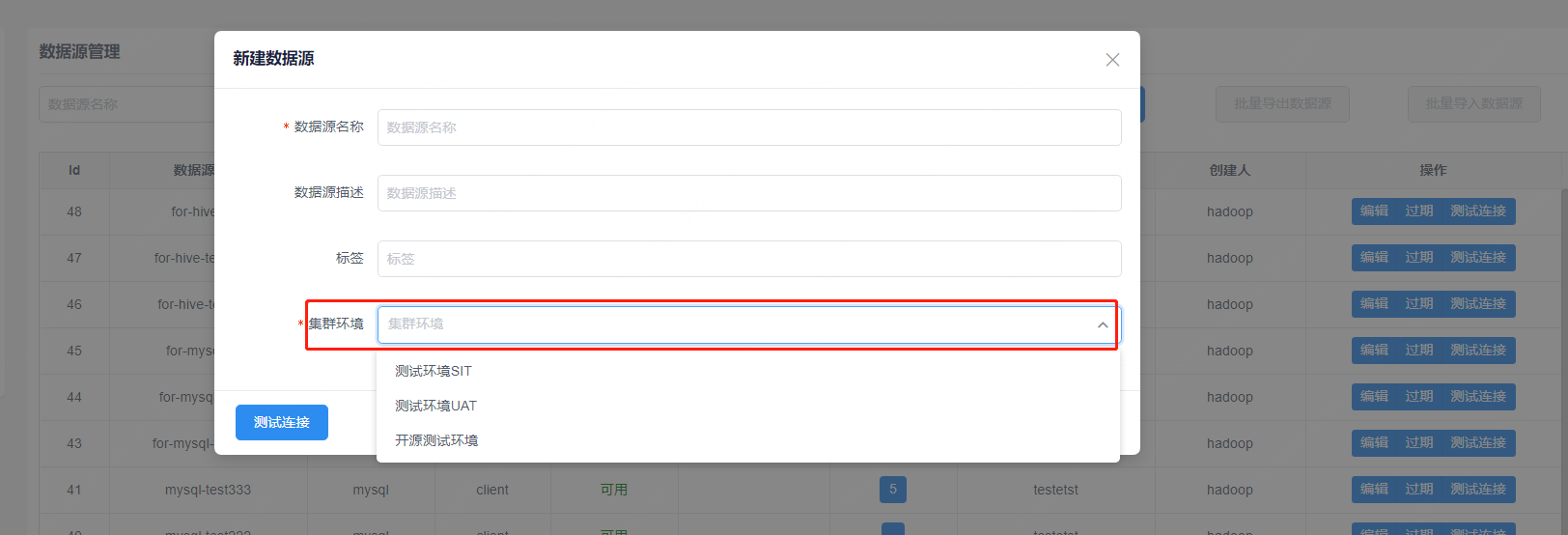
3.2.2 Using the client
package org.apache.linkis.datasource.client
import java.util
import java.util.concurrent.TimeUnit
import org.apache.linkis.common.utils.JsonUtils
import org.apache.linkis.datasource.client.impl.{LinkisDataSourceRemoteClient, LinkisMetaDataRemoteClient}
import org.apache.linkis.datasource.client.request._
import org.apache.linkis.datasource.client.response._
import org.apache.linkis.datasourcemanager.common.domain.DataSource
import org.apache.linkis.httpclient.dws.authentication.StaticAuthenticationStrategy
import org.apache.linkis.httpclient.dws.config.DWSClientConfigBuilder
import org.junit.jupiter.api.{Disabled, Test}
object TestHiveClient {
val gatewayUrl = "http://127.0.0.1:9001"
val clientConfig = DWSClientConfigBuilder.newBuilder
.addServerUrl(gatewayUrl)
.connectionTimeout(30000)
.discoveryEnabled(false)
.discoveryFrequency(1, TimeUnit.MINUTES)
.loadbalancerEnabled(true)
.maxConnectionSize(1)
.retryEnabled(false)
.readTimeout(30000)
.setAuthenticationStrategy(new StaticAuthenticationStrategy)
.setAuthTokenKey("hadoop")
.setAuthTokenValue("xxxxx")
.setDWSVersion("v1")
val dataSourceclient = new LinkisDataSourceRemoteClient(clientConfig.build())
val clientConfig2 = DWSClientConfigBuilder.newBuilder
.addServerUrl(gatewayUrl)
.connectionTimeout(30000)
.discoveryEnabled(false)
.discoveryFrequency(1, TimeUnit.MINUTES)
.loadbalancerEnabled(true)
.maxConnectionSize(1)
.retryEnabled(false)
.readTimeout(30000)
.setAuthenticationStrategy(new StaticAuthenticationStrategy)
.setAuthTokenKey("hadoop")
.setAuthTokenValue("xxxxx")
.setDWSVersion("v1")
val metaDataClient = new LinkisMetaDataRemoteClient(clientConfig2.build())
@Test
@Disabled
def testCreateDataSourceMysql: Unit = {
val user = "hadoop"
val system = "Linkis"
//create data source
val dataSource = new DataSource();
val dataSourceName = "for-hive-test"
dataSource.setDataSourceName(dataSourceName)
dataSource.setDataSourceDesc("this is for hive test")
dataSource.setCreateSystem(system)
dataSource.setDataSourceTypeId(4L)
val map = JsonUtils.jackson.readValue(JsonUtils.jackson.writeValueAsString(dataSource), new util.HashMap[String, Any]().getClass)
val createDataSourceAction: CreateDataSourceAction = CreateDataSourceAction.builder()
.setUser(user)
.addRequestPayloads(map)
.build()
val createDataSourceResult: CreateDataSourceResult = dataSourceclient.createDataSource(createDataSourceAction)
val dataSourceId = createDataSourceResult.getInsertId
// set connection parameters
val params = new util.HashMap[String, Any]
val connectParams = new util.HashMap[String, Any]
connectParams.put("envId", "3")
params.put("connectParams", connectParams)
params.put("comment", "init")
val updateParameterAction: UpdateDataSourceParameterAction = UpdateDataSourceParameterAction.builder()
.setUser(user)
.setDataSourceId(dataSourceId)
.addRequestPayloads(params)
.build()
val updateParameterResult: UpdateDataSourceParameterResult = dataSourceclient.updateDataSourceParameter(updateParameterAction)
val version: Long = updateParameterResult.getVersion
//publish configuration version
dataSourceclient.publishDataSourceVersion(
PublishDataSourceVersionAction.builder()
.setDataSourceId(dataSourceId)
.setUser(user)
.setVersion(version)
.build())
// use example
val metadataGetDatabasesAction: MetadataGetDatabasesAction = MetadataGetDatabasesAction.builder()
.setUser(user)
.setDataSourceName(dataSourceName)
.setSystem(system)
.build()
val metadataGetDatabasesResult: MetadataGetDatabasesResult = metaDataClient.getDatabases(metadataGetDatabasesAction)
val metadataGetTablesAction: MetadataGetTablesAction = MetadataGetTablesAction.builder()
.setUser(user)
.setDataSourceName(dataSourceName)
.setDatabase("linkis_test_ind")
.setSystem(system)
.build()
val metadataGetTablesResult: MetadataGetTablesResult = metaDataClient.getTables(metadataGetTablesAction)
val metadataGetColumnsAction = MetadataGetColumnsAction.builder()
.setUser(user)
.setDataSourceName(dataSourceName)
.setDatabase("linkis_test_ind")
.setSystem(system)
.setTable("test")
.build()
val metadataGetColumnsResult: MetadataGetColumnsResult = metaDataClient.getColumns(metadataGetColumnsAction)
}
}